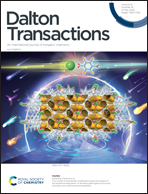Novel axially symmetric and unsymmetric silicon(iv) phthalocyanines having anti-inflammatory groups: synthesis, characterization and their biological properties†
Abstract
New asymmetric Si(IV)Pc (1), monomeloxicammonotriethyleneglycolmonomethylether (phthalocyaninano)silicone, axially ligated with meloxicam as a non-steroidal anti-inflammatory drug (NSAID), or triethylene glycol monomethyl ether and symmetric Si(IV)Pc (2), diclofenac(phthalocyaninano)silicone, axially ligated with two diclofenac as NSAID, were synthesized and characterized as antioxidant and antimicrobial agents together with polyoxo-SiPc (3), ditriethyleneglycolmonomethylether(phthalocyaninano)silicone, and SiPc(OH)2 (4), dihydroxy(phthalocyaninano)silicone. The photophysical and photochemical properties of these compounds were investigated. Then, antioxidant assays, including 2,2-diphenyl-1-picrylhydrazyl (DPPH) and ferrous ion chelating activities, were performed for these Si(IV) phthalocyanine derivatives (1, 2, 3 and 4). The highest DPPH scavenging activity of 73.48% was achieved with compound 2 and the highest ferrous chelating ability of 66.42% was obtained with compound 3. The results of the antioxidant assays indicated that Pc derivatives 1, 2 and 3 have remarkable superoxide radical scavenging activities, and moderate 2,2-diphenyl-1-picrylhydrazyl activities and metal chelating activities. The antimicrobial effects of the Si(IV) phthalocyanine compounds were studied against six pathogenic bacteria and two pathogenic microfungi. The results for the antimicrobial activity of these compounds indicated that Enterococcus faecalis (ATCC 29212) was the most sensitive microorganism and Pseudomonas aeruginosa (ATCC 27853) and Legionella pneumophila subsp. pneumophila (ATCC 33152) were the most resistant microorganisms against the tested compounds. The DNA cleavage ability and microbial cell viability of these compounds were studied. The studied compounds demonstrated excellent DNA nuclease activity and exhibited 100% cell viability inhibition at 500 mg L−1. Also, the antimicrobial photodynamic therapy of the compounds was tested against Escherichia coli (ATCC 25922) and significant photodynamic antimicrobial activity was observed. In addition, the effect of phthalocyanines on biofilm inhibition produced by Staphylococcus aureus (ATCC 25923) was also tested and 3 showed excellent biofilm inhibition of 82.14%.



 Please wait while we load your content...
Please wait while we load your content...